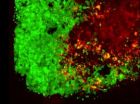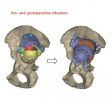(Press-News.org) DURHAM, N.C. – When it comes to treating kidney stones, less invasive may not always be better, according to new research from Duke Medicine.
In a direct comparison of shock wave lithotripsy vs. ureteroscopy – the two predominant methods of removing kidney stones – researchers found that ureteroscopy resulted in fewer repeat treatments.
The findings were published May 16, 2014, in the journal JAMA Surgery, coinciding with presentation at the annual meeting of the American Urological Association.
"Nearly one out of 11 people in the United States has kidney stones, leading to more than $10 billion a year in treatment costs," said lead author Charles D. Scales Jr., M.D., assistant professor of surgery at Duke. "As we explore ways to improve value in the health care system, we need to look at the kinds of things that drive costs up; reducing the number of repeat procedures is one place to start."
Scales and colleagues analyzed data for nearly 48,000 insured patients in the United States who sought emergency room or urgent care treatment for kidney stones from 2002-10.
Roughly half the patients received shock wave lithotripsy, a non-invasive approach that focuses pressure waves on the stones to break them into tiny pieces that can then pass painlessly. The other half of patients underwent ureteroscopy, a minimally invasive procedure that uses a laser to break up the stone, and a thin scope that travels through the urethra to snare the stone in a small basket for removal.
Within 120 days of the initial procedure, approximately one in five of the patients needed a second treatment. The researchers focused their comparison on patients who were equally qualified for either procedure. Among that group, 11 percent of patients undergoing shock wave lithotripsy needed a second procedure, while less than 1 percent of ureteroscopy patients needed an additional treatment.
"Our findings add new insight, since most of published research around the effectiveness of the procedures was conducted years ago, when the technology was new," Scales said. In the past 20 years, he said, many experts believe shock wave lithotripsy has become less effective as the devices underwent design changes to improve safety. At the same time, ureteroscopy improved with better endoscopes and laser technology."
The researchers noted that the findings have important policy implications around Medicare reimbursements. For treating kidney stones, Medicare currently pays about $700 for a patient to receive lithotripsy, but only about $400 for a patient to receive the endoscopic ureteroscopy treatment, which the study found to be more effective.
The researchers suggested that differences in effectiveness, invasiveness and costs highlight important tradeoffs between the two procedures. In all cases, Scales said, the decision to undergo shock wave lithotripsy or ureteroscopy should be carefully considered by both the doctor and the patient.
"Many patients believe that because nothing is inserted into the body, shock wave lithotripsy is better, but that may not always be the case," Scales said. "There can be important tradeoffs for having the non-invasive procedure. One question to ask is about the likelihood of a second procedure, and the impact that might have on the cost of care and the time off work."
INFORMATION:
In addition to Scales, study authors include Julie C. Lai; Andrew W. Dick; Jan M. Hanley; Jeroen van Meijgaard; Claude M. Setodji; and Christopher S. Saigal.
The Robert Wood Johnson Foundation Clinical Scholars Program funded the study, along with the U.S. Department of Veterans Affairs, and the National Institute of Diabetes and Digestive and Kidney Diseases (HHSN276201200016C).
Non-invasive lithotripsy leads to more treatment for kidney stones
2014-05-16
ELSE PRESS RELEASES FROM THIS DATE:
Cognitive behavioral or relaxation training helps women reduce distress during breast cancer treatment
2014-05-16
Coral Gables, Fla. (May 16, 2014) – Can psychological intervention help women adapt to the stresses of breast cancer? It appears that a brief, five-week psychological intervention can have beneficial effects for women who are dealing with the stresses of breast cancer diagnosis and surgery. Intervening during this early period after surgery may reduce women's distress and providing cognitive or relaxation skills for stress management to help them adapt to treatment.
Researchers at the University of Miami recruited 183 breast cancer patients from surgical oncology clinics ...
Spiders spin possible solution to 'sticky' problems
2014-05-16
Researchers at The University of Akron are again spinning inspiration from spider silk—this time to create more efficient and stronger commercial and biomedical adhesives that could, for example, potentially attach tendons to bones or bind fractures.
The Akron scientists created synthetic duplicates of the super-sticky, silk "attachment discs" that spiders use to attach their webs to surfaces. These discs are created when spiders pin down an underlying thread of silk with additional threads, like stiches or staples, explains Ali Dhinojwala, UA's H. A. Morton professor ...
With imprecise chips to the artificial brain
2014-05-16
This news release is available in German. Which circuits and chips are suitable for building artificial brains using the least possible amount of power? This is the question that Junior Professor Dr. Elisabetta Chicca from the Center of Excellence Cognitive Interaction Technology (CITEC) has been investigating in collaboration with colleagues from Italy and Switzerland.
Their surprising finding: Constructions that use not only digital but also analog compact and imprecise circuits are more suitable for building artificial nervous systems, rather than arrangements ...
Lighting the way to graphene-based devices
2014-05-16
Graphene continues to reign as the next potential superstar material for the electronics industry, a slimmer, stronger and much faster electron conductor than silicon. With no natural energy band-gap, however, graphene's superfast conductance can't be switched off, a serious drawback for transistors and other electronic devices. Various techniques have been deployed to overcome this problem with one of the most promising being the integration of ultrathin layers of graphene and boron nitride into two-dimensional heterostructures. As conductors, these bilayered hybrids ...
Herpes-loaded stem cells used to kill brain tumors
2014-05-16
Harvard Stem Cell Institute (HSCI) scientists at Massachusetts General Hospital have a potential solution for how to more effectively kill tumor cells using cancer-killing viruses. The investigators report that trapping virus-loaded stem cells in a gel and applying them to tumors significantly improved survival in mice with glioblastoma multiforme, the most common brain tumor in human adults and also the most difficult to treat.
The work, led by Khalid Shah, MS, PhD, an HSCI Principal Faculty member, is published in the Journal of the National Cancer Institute. Shah heads ...
Ataluren Phase 3 trial results in nonsense mutation cystic fibrosis
2014-05-16
SOUTH PLAINFIELD, NJ – May 16, 2014 – PTC Therapeutics, Inc. (NASDAQ: PTCT) today announced that the results of a Phase 3 study of ataluren in patients with nonsense mutation cystic fibrosis (nmCF) were published in Lancet Respiratory Medicine. The results demonstrated positive trends in both the primary endpoint, lung function as measured by relative change in % predicted FEV1 (forced expiratory volume in one second) and in the secondary outcome measure, rate of pulmonary exacerbations. The collective data from this trial, including retrospective and subgroup analyses ...
Glasses-free 3-D projector
2014-05-16
Over the past three years, researchers in the Camera Culture group at the MIT Media Lab have steadily refined a design for a glasses-free, multiperspective, 3-D video screen, which they hope could provide a cheaper, more practical alternative to holographic video in the short term.
Now they've designed a projector that exploits the same technology, which they'll unveil at this year's Siggraph, the major conference in computer graphics. The projector can also improve the resolution and contrast of conventional video, which could make it an attractive transitional technology ...
Growing camelina and safflower in the Pacific Northwest
2014-05-16
A recent study published in Agronomy Journal provides information important to farmers growing oilseed crops. In the study, camelina and safflower were grown in three-year rotations with winter wheat and summer fallow. The study shows that using this rotation may require that no tillage should be done to the soil during the fallow year. Oilseed crops produce relatively little residue—organic material such as roots that hold the soil together. Even light tillage can disintegrate the soil.
A cooperative study by the USDA-ARS and Washington State University researched the ...
How Asian American 'tiger mothers' motivate their children
2014-05-16
An article titled "Why Chinese Mothers Are Superior," published in The Wall Street Journal in 2011, has continued to provoke a cultural debate among parents after self-proclaimed 'tiger mother' Amy Chua asserted that Asian American parenting methods produce more successful children. Researchers at Stanford University delved deeper into Chua's 'tiger mother' approach, and their research sheds light on key fundamental differences in parenting methods between Asian Americans and European Americans.
To reveal the cultural differences in parenting, the researchers compare ...
Ground breaking hip and stem cell surgery in Southampton
2014-05-16
Doctors and scientists in Southampton have completed their first hip surgery with a 3D printed implant and bone stem cell graft.
The 3D printed hip, made from titanium, was designed using the patient's CT scan and CAD CAM (computer aided design and computer aided manufacturing) technology, meaning it was designed to the patient's exact specifications and measurements.
The implant will provide a new socket for the ball of the femur bone to enter. Behind the implant and between the pelvis, doctors have inserted a graft containing bone stem cells.
The graft acts as ...





